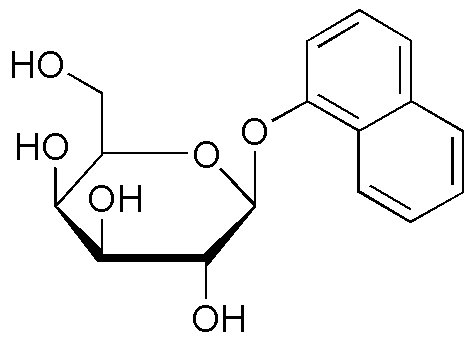1-Naphthyl-b-D-galactopyranoside is widely utilized in research focused on:
- Enzyme Activity Assays: This compound serves as a substrate for various glycosidases, allowing researchers to measure enzyme activity in biochemical assays. Its specificity helps in understanding enzyme kinetics and mechanisms.
- Cell Biology: It is used in cell culture studies to investigate the uptake and metabolism of carbohydrates, providing insights into cellular processes and signaling pathways.
- Fluorescent Labeling: When conjugated with fluorescent dyes, it can be used for labeling cellular components, enhancing visualization in microscopy and flow cytometry applications.
- Drug Development: The compound aids in the screening of potential drug candidates that target glycosylation processes, which are crucial in many diseases, including cancer.
- Food Industry: It can be utilized to assess the activity of enzymes in food products, helping manufacturers optimize processes for better quality and flavor.
General Information
Properties
Safety and Regulations
Applications
1-Naphthyl-b-D-galactopyranoside is widely utilized in research focused on:
- Enzyme Activity Assays: This compound serves as a substrate for various glycosidases, allowing researchers to measure enzyme activity in biochemical assays. Its specificity helps in understanding enzyme kinetics and mechanisms.
- Cell Biology: It is used in cell culture studies to investigate the uptake and metabolism of carbohydrates, providing insights into cellular processes and signaling pathways.
- Fluorescent Labeling: When conjugated with fluorescent dyes, it can be used for labeling cellular components, enhancing visualization in microscopy and flow cytometry applications.
- Drug Development: The compound aids in the screening of potential drug candidates that target glycosylation processes, which are crucial in many diseases, including cancer.
- Food Industry: It can be utilized to assess the activity of enzymes in food products, helping manufacturers optimize processes for better quality and flavor.
Documents
Safety Data Sheets (SDS)
The SDS provides comprehensive safety information on handling, storage, and disposal of the product.
Product Specification (PS)
The PS provides a comprehensive breakdown of the product’s properties, including chemical composition, physical state, purity, and storage requirements. It also details acceptable quality ranges and the product's intended applications.
Certificates of Analysis (COA)
Search for Certificates of Analysis (COA) by entering the products Lot Number. Lot and Batch Numbers can be found on a product’s label following the words ‘Lot’ or ‘Batch’.
*Catalog Number
*Lot Number
Certificates Of Origin (COO)
This COO confirms the country where the product was manufactured, and also details the materials and components used in it and whether it is derived from natural, synthetic, or other specific sources. This certificate may be required for customs, trade, and regulatory compliance.
*Catalog Number
*Lot Number
Safety Data Sheets (SDS)
The SDS provides comprehensive safety information on handling, storage, and disposal of the product.
DownloadProduct Specification (PS)
The PS provides a comprehensive breakdown of the product’s properties, including chemical composition, physical state, purity, and storage requirements. It also details acceptable quality ranges and the product's intended applications.
DownloadCertificates of Analysis (COA)
Search for Certificates of Analysis (COA) by entering the products Lot Number. Lot and Batch Numbers can be found on a product’s label following the words ‘Lot’ or ‘Batch’.
*Catalog Number
*Lot Number
Certificates Of Origin (COO)
This COO confirms the country where the product was manufactured, and also details the materials and components used in it and whether it is derived from natural, synthetic, or other specific sources. This certificate may be required for customs, trade, and regulatory compliance.


